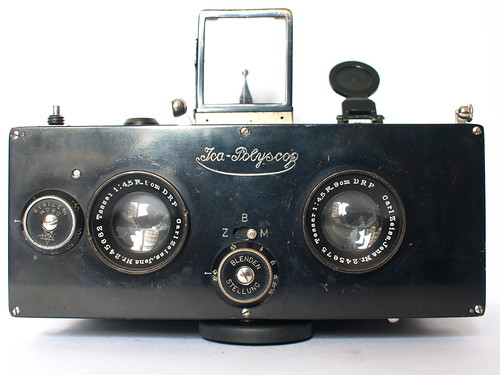Polyscop

|
| With Jena Tessar 9cm f/4.5 lenses image by Alex Steindorff (Image rights) |
Polyscop cameras are a series of stereo plate cameras made in the 1910s into the early 1920s. A first model has been introduced in about 1908 to 1910 by the small swiss camera maker Zulauf and raised the attention of Carl Zeiss, who delivered the lenses and were distributing Zulauf cameras in UK and elsewhere. They convinced Gottlieb Zulauf to join the Internationale Camera Actiengesellschaft ICA. Camera production moved to Dresden in 1911 and G. Zulauf became technical director. Later ICA Polyscop cameras were offered in two plate formats: 45x107mm and 6x13cm as well as rigid-bodied and strut-folding versions. Some of the cameras have a waist-level finder, with its lens in the lens board, between and below the two taking lenses, so that the camera looks rather like the Stereflektoskop or the Heidoscop. It is not clear whether this finder gives reflex focusing; all the cameras have helical focus with a lever behind the lens board. There is also a folding direct-view finder (a Newton finder) mounted on most examples seen. The example linked below at Leitz Photographica Auction does not have the Newton finder, but this camera has definitely been modified; it also has a custom-made roll-film back instead of a plate holder or magazine.
Links
- ICA Polyscop user manual at Butkus.org
- Examples at Sylvain Halgand's Collection Appareils (French text):
- Polyscop for 45x107mm plates, with 60mm f/4.5 Optis Paris anastigmat lenses. Strut-folding body (which saves very little space when the camera is fitted with the twelve-plate magazine).
- Polyscop for 6x13cm plates, with 9cm f/4.5 Tessar lenses. Rigid body; much the same specification as the camera illustrated here, but placement of the shutter speed, aperture and viewfinder are all different! With twelve-plate magazine.
- Polyscop sold at the 36th Leitz Photographica Auction, on 13 June 2020. Customised with permanently-attached roll-film back for 120 film, though the camera is plainly originally for 45x107mm plates. 62mm f/4,5 Tessar lenses, apparently with sliding aperture plates, not an iris diaphragm. No direct-view finder (but this could have been removed with the customisation). With tripod bush and bubble level on both the top and the bottom!